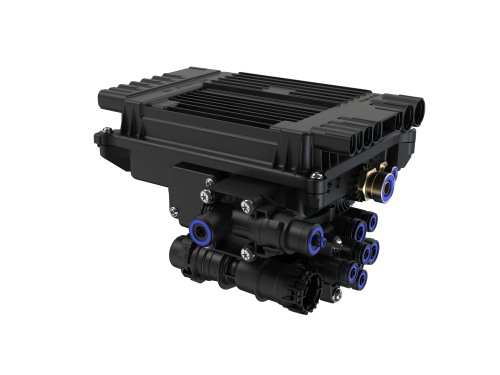Haldex New brake platform strategy

The new EBS for trailers, which now controls the parking brake electronically, offers customers a new and modular approach in regard to specifications and application software.
In contrast to previous brake control units, the next generation has electronically controlled braking systems (EBS) for trailers EB+ 4.0, which means that customers can now release the parking brake via an electronic, instead of a pneumatic controller. This enables us to provide our customers with new features, such as for instance the trailer immobiliser, which prevents the brake from being released in the event of unauthorised access; the “Safe Parking+” feature, which prevents the parking brake from being released until the compressed air system is completely full and the control line is pressurised; plus an emergency brake override, which prevents automatic emergency braking if the compressed air supply line is interrupted – as long as the semi-trailer is moving and the electrical connection is intact. This increases road safety and minimises tyre wear.
Unlike previous EBS systems, the EB+ 4.0 can be upgraded from the basic unit, which in order to reduce weight and CO2, is now produced from engineering grade plastic. Plus, with the customisation option, essential features with all kinds of requirements and budgets, can be selected accordingly. In addition to this, a new combined park & shunt valve family, TEM+, is being introduced. The valves can also be configured in such a way that the spring brake is automatically actuated during coupling and uncoupling or pressure loss in the supply line.

The modular design allows you to replace individual elements or upgrade others. Four different EB+ 4.0 versions are available: a basic EBS with two modulators and two-wheel speed sensors with no emergency brake override; a basic EBS with emergency brake override; a premium EBS with two additional electrical interfaces, which can be extended to eight sensors and four modulators; and an additional modulator, which is used to map larger systems.
Whichever specification you choose, it is based on a flexible design, which doesn’t stop at EBS. The Senior Commercial Product Manager at Haldex, Alexander Kraus, explains: “EB+ 4.0 isn’t just a platform for EBS. It’s also a platform for ABS. Even if one is based on “Brake-by-wire” and the other on “Brake-by-Air”, both use the same wheel speed sensors.”
The EB+ 4.0 supports a 12V and 24V voltage supply of the vehicle, thereby making it suitable for customers in all global markets. This includes Europe with a 90% EBS application, the USA where the demand is for ABS with “Roll Stability”, and Asia where a conventional ABS is most common. All three are a similar size, have the same pipe connections, and the chassis mounting interface is compatible with the previous EBS generation. This simplifies the product range, contributes to a reduction in manufacturing costs and optimises the integration for OEM customers.
Modularity has also been applied to software architecture. The new software concept separates the safety-related brake control software from the customer-specific application software.,. This means that for example input from the telematics unit could be added with the programming interface (API – Application Programming Interface). Haldex is quite flexible when it comes to implementing such modifications. On behalf of the customer, the company can develop customised functionalities or incorporate customer functions into regular software updates, and by the same token, a customer-specific release plan can also be agreed.
What is important is that changes like these to the application software – unlike for previous versions, – do not lead to the need for new type approvals. This open system architecture not only removes any restrictions during the update process of the system software, but it also speeds up the implementation of desired software changes and the elimination of software errors (Bugfix). What is more, it also offers greater customer flexibility when developing digital solutions and gives Haldex the competitive edge.
Other new EB+ 4.0 components include the control solenoids of the service brake, pressure modulators with a newly developed relay valve concept and the new electronic control unit with space-saving electrical connections. All EBS units and peripheral devices communicate via the new diagnostic communication protocol UDS (Unified Diagnostic Services) in the automotive sector and are thereby replacing the previous Keyword 2000 protocol. This change also contributed to the design of a sustainable system.
This way of thinking goes as far as the front-end. The newly developed software DIAG++, still with its familiar appearance and developed with Microsoft.Net, includes the system service module, data analysis module Fleet+ and the diagnostic software. The newly developed graphical user interface simplifies the configuration of complex systems.









